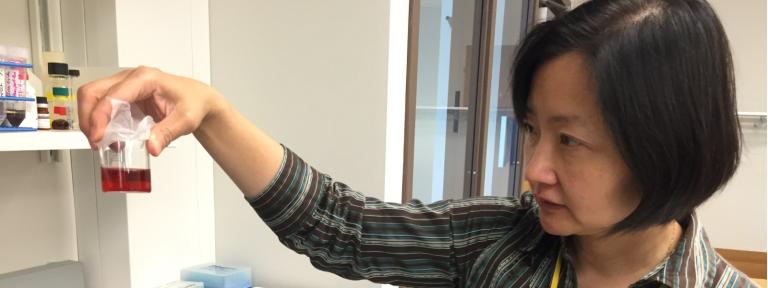
“If you connect a targeting molecule to a drug and the targeting molecule binds to the cancer cells, you would be able to see the cancer cells.”
In bulk, gold is often an adored object of beauty with deep-seated cultural significance across the globe. But at a microscopic level, elemental gold’s properties may have inspiring biomedical applications for drug delivery during cancer treatment.
Dr. Lihua Wang, associate professor of BioInorganic Chemistry, is currently examining the unique properties and potential applications of gold at Kettering University.
“We are interested in the biomedical applications of gold nanoparticles because they are non-toxic and non-immunogenics which means they don’t cause an immune system reaction,” Wang said.
Wang is constructing microscopic gold nanoparticles and hollow gold nanospheres that are so small that their properties differ from bulk gold.
“Since the size is small, the gold nanoparticles have a high surface area to volume ratio,” Wang said. “This allows us to pack or load molecules in the gold nanoparticle or sphere.”
Gold nanoparticles are small enough to penetrate individual cells and sometimes the nucleus of cells to directly interact with DNA. If a drug was bound to a gold nanoparticle or packed in a gold nanosphere, it could be delivered directly to the microscopic components of tumor cells in the body.
The gold nanoparticles and nanospheres are also colored depending on the size of the nanostructures and the wall thickness in the case of nanospheres. Gold nanoparticles have a distinct red color while gold spheres or shells can be blue or green. This permits targeting as Wang and her colleague are able to decipher where these particles travel and how they interact in the body.
“If you connect a targeting molecule to a drug and the targeting molecule binds to the cancer cells, you would be able to see the cancer cells,” Wang said.
Wang’s research will be enhanced by Kettering’s recent National Science Foundation - Major Research Instrument grant that allowed for the acquisition of an isothermal titration calorimeter (ITC). From a thermodynamics perspective, the energetics of molecular interactions consist of entropic (disorder) and enthalpic (heat released or absorbed) components which can be deconvoluted using an ITC. Wang will be able to learn more about the interaction between gold nanoparticles and potential drugs by developing a better understanding of the binding energetics between them.
Wang is currently studying both the interactions between gold nanoparticles and potential cancer treatment molecules as well as the stability of gold nanoparticles and spheres in the presence of metal ions. Metal ions such as sodium, potassium, calcium, magnesium, etc. are commonly found in biological solutions.
Wang is exposing gold nanoparticle coated with different compounds (ligands) to different concentrations of metal ions (sodium, magnesium, copper, zinc etc) to determine the stability of the ligand-coated gold nanoparticles and spheres in the presence of these metal ions.
“You don’t want these particles to precipitate,” Wang said. “You want them to remain suspended in solution. My data will help people design particles that are stable in biological solutions.”
The hope is that those stable particles will carry anti-cancer drugs with them for targeted and selected treatment of the often fatal disease.